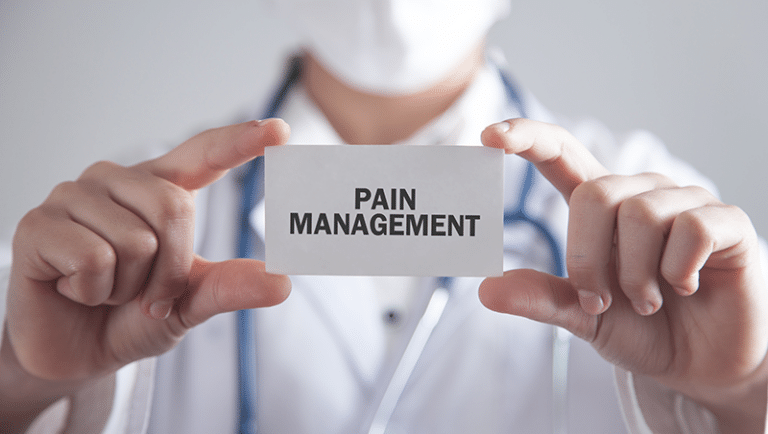Pain Management in Patients with Disabilities

Living with a disability can present many challenges, including managing pain, which can make daily life even more difficult. How can individuals with disabilities manage their pain effectively?
The CDC reports that 61 million American adults have disabilities. Chronic pain is often an additional challenge for these individuals and can reduce their quality of life. Managing pain in patients with disabilities requires a customized approach due to their physical limitations and medical conditions, which may restrict their pain relief options.
At Momentum Medical, we understand the importance of effective pain management for individuals with disabilities. We will explore the challenges of pain management in this population and provide practical tips and strategies for managing pain effectively. This article offers valuable insights into pain management for both patients with disabilities and healthcare providers.
What Is Pain and Its Types?
Pain is a complex experience that includes physical and emotional responses. At its core, pain is a signal that there is a problem in the body.
Pain is usually felt when nerves detect tissue damage or potential damage and send signals to the brain. The brain then interprets these signals as pain. Many factors, including genetics, culture, and life experiences, can influence the sensation of pain.
Types of Pain
1. Acute Pain
It is a type of pain that comes on suddenly and is usually caused by injury or trauma. It is a sharp, intense pain that typically lasts for a short period of time. Acute pain is a natural response to injury or tissue damage, and it usually subsides as the body heals.
2. Chronic Pain
Chronic pain is pain that can last for or more than three months. It can potentially affect any part of the body and can be incapacitating, significantly impacting a person’s quality of life.
3. Neuropathic Pain
Neuropathic pain is a result of nervous system damage or dysfunction. It is often described as a burning or shooting pain and can be challenging to treat. Neuropathic pain can be caused by diabetes, multiple sclerosis, or nerve damage from injury.
4. Inflammatory Pain
Inflammatory pain occurs when the body becomes inflamed. It frequently coexists with diseases like fibromyalgia, inflammatory bowel disease, or arthritis. Inflammatory pain can be chronic and can lead to significant disability.
5. Psychogenic Pain
Psychogenic pain is a type of pain caused by psychological factors like stress, anxiety, or depression.
It’s usually described as a dull, achy pain that’s tough to manage. Psychogenic pain commonly accompanies chronic pain conditions and can hinder recovery significantly.
Importance of Pain Management in Patients with Disabilities
Pain management is crucial for patients with disabilities as they often experience chronic pain that can affect their quality of life. Due to their condition, they may have limited mobility or sensory impairments, which can make it challenging to communicate their pain effectively.
Proper pain management can enhance patients’ physical and emotional health, enabling them to engage in daily activities and improve their overall quality of life.
Healthcare providers must comprehend the distinctive difficulties experienced by patients with disabilities and devise customized pain management techniques to cater to their distinct necessities.
Understanding Pain in Patients with Disabilities
Disabilities can alter a person’s pain perception. Common disabilities include:
- Physical disabilities like spinal cord injuries, amputations, and cerebral palsy;
- Neurological disabilities such as Parkinson’s disease, multiple sclerosis, and stroke.
These disabilities can impact an individual’s ability to move, communicate, and experience sensations, which can all affect their experience of pain.
Factors That Can Exacerbate Pain in Patients with Disabilities
1. Lack of mobility: One of the most significant factors that can exacerbate pain in patients with disabilities is a lack of mobility. When you are unable to move freely, you are more likely to experience pain and discomfort. This is especially true for patients confined to a wheelchair or bedridden. To manage pain effectively, finding ways to stay active and maintain a healthy range of motion is essential.
2. Poor posture: Poor posture is another common factor that can exacerbate pain in patients with disabilities. Poor posture can strain your muscles and joints, causing discomfort and pain.
To prevent this, it’s crucial always to maintain good posture and invest in ergonomic chairs or other equipment that properly support your body.
3. Stress and anxiety: Stress and anxiety can also exacerbate pain in patients with disabilities. When stressed or anxious, your body releases hormones that can increase inflammation and pain.
To effectively manage pain, it’s crucial to decrease stress and anxiety levels by utilizing relaxation techniques like meditation or yoga.
4. Lack of sleep: Lack of sleep is another factor that can exacerbate pain in patients with disabilities. When you lack sleep, your body is more sensitive to pain, and your pain threshold is lower.
To manage pain effectively, getting enough sleep each night and establishing healthy sleep habits is essential.
5. Poor diet: Finally, a poor diet can also exacerbate pain in patients with disabilities.
Consuming processed foods, sugar, and saturated fats can heighten inflammation, resulting in discomfort and pain. To effectively manage pain, it is crucial to maintain a balanced and nutritious diet that includes whole grains, lean protein, fruits, and vegetables.
Living with a disability can be challenging, but managing pain effectively can help improve your quality of life. To reduce your pain and enhance your life’s comfort, address all factors that can worsen pain in patients with disabilities.
Importance of Effective Communication and Assessment of Pain in Patients with Disabilities
Healthcare providers must communicate effectively and carefully assess pain in patients with disabilities due to its complexity. This may involve using alternative methods of communication, such as sign language or assistive technology, to ensure that patients are able to express their pain effectively.
Pain Management Strategies for Patients with Disabilities
Pharmacological Interventions
Pharmacological interventions are one of the most common pain management strategies used by patients with disabilities. Pain medications such as opioids, NSAIDs, and topical analgesics are often prescribed to manage pain. Pain medications can have side effects and may not be suitable for everyone. It’s crucial to consult with a healthcare professional before taking any medications.
Non-Pharmacological Interventions
Non-pharmacological interventions are becoming increasingly popular in pain management.
- Physical therapy is one of the most common and can help to improve strength, flexibility, and range of motion, which can help to reduce pain levels.
- Cognitive-behavioral therapy is another non-pharmacological intervention that can help to manage pain. This type of therapy can help patients change their thoughts and behaviors related to pain, reducing pain levels.
Assistive Devices for Pain Management
Assistive devices are another effective pain management strategy for patients with disabilities.
Braces and mobility aids can reduce pain by providing support and relieving pressure on the affected area. A knee brace eases joint pain and inflammation, while a wheelchair reduces walking pain.
Special Considerations for Pain Management in Patients with Disabilities
Challenges in Administering Pain Medication to Patients with Disabilities
Administering pain medication to patients with disabilities can be challenging due to various factors.
For instance, patients with communication disabilities may have difficulty expressing their pain levels, which can lead to under-treatment.
Additionally, patients with physical disabilities may have difficulty swallowing pills or require alternative administration routes, such as transdermal patches or injections.
Importance of Individualized Pain Management Plans for Patients with Disabilities
Individualized pain management plans are crucial for patients with disabilities because their pain management needs may vary significantly from those without disabilities.
A standardized approach to pain management is not practical for these particular patients.
To create a personalized pain management plan that meets the patient’s unique needs, healthcare providers must consider their disability, medical records, and pain level.
Multidisciplinary Approach to Pain Management in Patients with Disabilities
Pain management in patients with disabilities requires a multidisciplinary approach that involves various healthcare professionals, such as physicians, nurses, physical therapists, and occupational therapists.
They can work together to develop a comprehensive pain management plan. The plan should address the patient’s physical, emotional, and psychological needs. Healthcare providers can work together to ensure the best patient pain management outcome.
Additionally, they may collaborate with other specialists, such as pain management specialists or palliative care teams, to ensure optimal pain management for the patient.
Healthcare providers should also consider the patient’s cultural and linguistic background, as well as their cognitive and communication abilities.
Future Directions for Research in Pain Management for Patients with Disabilities
Despite the progress made in pain management for patients with disabilities, further research is still needed. Future studies should focus on developing more effective pain management approaches tailored to the patient’s needs.
Research should also explore the impact of pain on the quality of life of patients with disabilities and their caregivers. Additionally, there is a need to investigate the long-term effects of pain medications and alternative therapies on these patients.
Choose us at Momentum Medical for your Pain Management.
Pain management for patients with disabilities is a crucial healthcare aspect requiring a multidisciplinary approach. Healthcare providers, caregivers, and patients themselves should work together to develop effective pain management strategies that improve the patient’s quality of life.
Further research is needed to develop more targeted pain management approaches and explore the long-term effects of pain medications and alternative therapies. Working together can help patients with disabilities manage their pain and live fulfilling lives. The team at Momentum Medical is confident that we can provide you with an interventional way to deal with pain problems, regardless of your disability. Contact us today to learn more or to set up an appointment.
